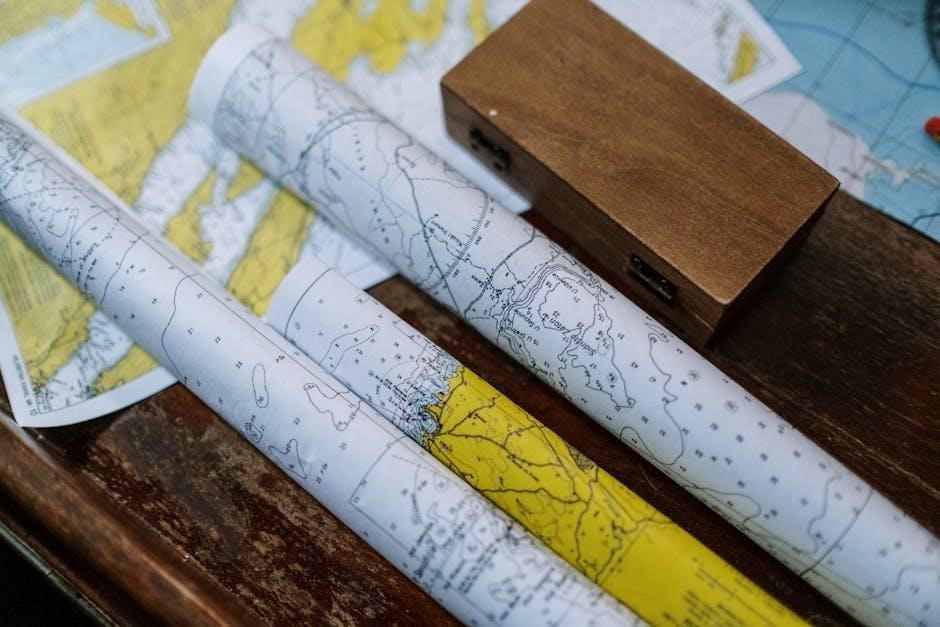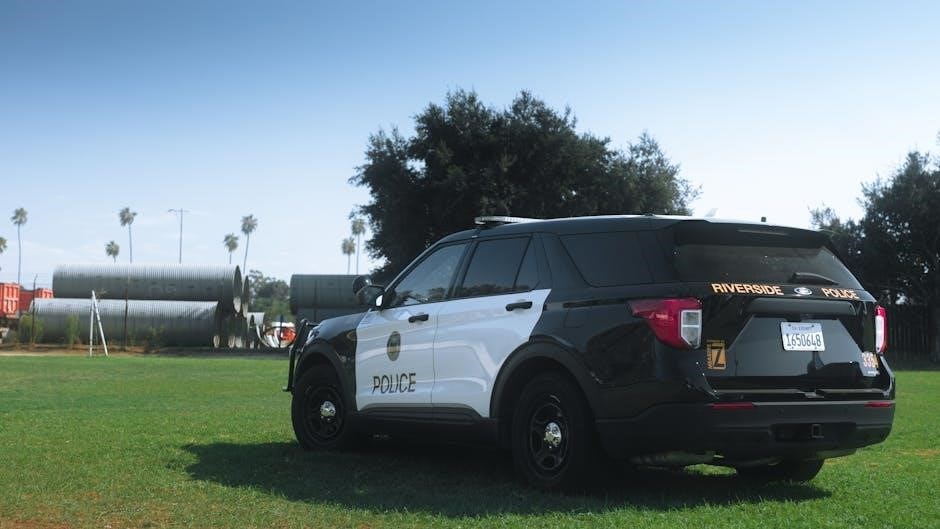Welcome to the 2002 Ford Explorer Fuse Box Guide, your comprehensive resource for understanding and maintaining your vehicle’s electrical system․ This guide provides detailed insights into the fuse box layout, locations, and troubleshooting tips to help you manage electrical components efficiently․
1․1 Overview of the Fuse Box System
The 2002 Ford Explorer’s fuse box system is a critical component that protects and controls the vehicle’s electrical circuits․ It consists of multiple fuse boxes located in the passenger compartment and engine area․ Each fuse box houses fuses and relays that regulate power distribution to various electrical components, such as lighting, entertainment, and safety systems․ Understanding this system is essential for troubleshooting and maintaining your Explorer’s electrical health․ The fuse boxes are designed to safeguard against overloads and short circuits, ensuring reliable operation of all connected systems․ Referencing the fuse box diagrams and specifications is crucial for accurate diagnostics and repairs․
1․2 Importance of Understanding Fuse Box Layout
Understanding the fuse box layout is essential for safely and effectively diagnosing and resolving electrical issues in your 2002 Ford Explorer․ Knowing the location and function of each fuse ensures proper troubleshooting and prevents potential damage to the vehicle’s electrical systems․ A clear understanding helps identify blown fuses quickly, reducing downtime and avoiding further complications․ Additionally, it allows for accurate replacement with the correct fuse type, maintaining system reliability․ Familiarity with the fuse box layout is vital for both novice and experienced owners, as it empowers them to address common issues confidently and efficiently without risking additional harm to the vehicle’s electrical components․
1․3 Key Features of the 2002 Ford Explorer Fuse Box
The 2002 Ford Explorer fuse box features a streamlined design with clearly labeled fuses and relays, enhancing accessibility and ease of use․ It includes two primary fuse panels: one in the passenger compartment and another in the engine compartment․ The passenger-side panel is conveniently located behind the glove box, while the engine compartment fuse box provides easy access to essential electrical components․ Each fuse is color-coded and specified by amp rating, ensuring precise identification and replacement․ The system also incorporates a fuse puller tool for safe removal and installation, making maintenance straightforward and efficient for owners of all skill levels․

Locations of Fuse Boxes in the 2002 Ford Explorer
The 2002 Ford Explorer features fuse boxes located in two primary areas: the passenger compartment and the engine compartment․ Additional fuse boxes may exist depending on the vehicle’s configuration․
2․1 Passenger Compartment Fuse Panel
The passenger compartment fuse panel is located behind the glove box․ To access it, open the glove box, press the sides inward, and swing it down․ This panel contains fuses for various interior electrical systems, such as lighting, infotainment, and accessories․ It is essential to consult the fuse diagram to identify the correct fuse for specific components․ Always turn off the ignition and ensure the vehicle is safe before handling fuses․ This panel is a key part of the Explorer’s electrical system, providing easy access for troubleshooting and maintenance․

2․2 Engine Compartment Fuse Box
The engine compartment fuse box is located on the driver’s side of the engine bay․ It is typically found near the battery and is protected by a cover․ This fuse box controls essential systems such as the engine, ignition, cooling, and charging․ To access it, open the hood and remove the fuse box cover․ Inside, you’ll find high-current fuses that protect vital components․ Always refer to the fuse diagram on the underside of the cover or in your owner’s manual for accurate identification․ Ensure the ignition is off before handling any fuses to avoid potential electrical issues․
2․3 Additional Fuse Boxes (if applicable)
In some 2002 Ford Explorer models, additional fuse boxes may be installed to support optional features or aftermarket upgrades․ These are typically found in the cargo area, behind the rear seats, or near the trailer tow package․ They are designed to handle specialized circuits like auxiliary power, towing electrics, or upgraded audio systems․ Always consult your owner’s manual or a certified diagram for precise locations and assignments․ If additional fuse boxes are present, ensure they are inspected during regular maintenance to prevent electrical issues․ Remember to disconnect the battery before working on any fuse box to avoid accidental short circuits․

Accessing the Fuse Boxes
Accessing the fuse boxes in your 2002 Ford Explorer involves opening the glove box for the passenger panel and lifting the hood for the engine compartment․
3․1 Steps to Access the Passenger Compartment Fuse Panel
To access the passenger compartment fuse panel in your 2002 Ford Explorer, start by opening the glove box․ Press the sides inward and swing it down to reveal the fuse panel․ This panel is located behind the glove box and contains fuses for various interior electrical systems․ Ensure the glove box is fully open and secure to access the fuses safely․ This compartment houses essential fuses for systems like lighting, accessories, and more․ Always handle fuses carefully to avoid damage to the electrical system․
3․2 How to Access the Engine Compartment Fuse Box
To access the engine compartment fuse box in your 2002 Ford Explorer, start by opening the hood․ Locate the fuse box near the battery, typically on the driver’s side․ It is secured with a latch or clip․ Open the fuse box by releasing the latch or sliding the clip․ Inside, you’ll find fuses for essential systems like the engine, cooling fan, and ABS․ Always handle the fuses carefully to avoid damage․ This fuse box is crucial for diagnosing and resolving issues related to your vehicle’s powertrain and other critical functions․ Ensure the hood is securely closed after inspection․

Understanding the Fuse Box Layout
The 2002 Ford Explorer fuse box layout is designed to simplify electrical system management․ It includes labeled fuses for various components, ensuring easy identification and replacement․ Use the diagram to locate specific fuses and understand their ratings, enabling safe and efficient troubleshooting of electrical issues․
4․1 Reading the Fuse Box Diagram
Reading the fuse box diagram for the 2002 Ford Explorer is essential for identifying and troubleshooting electrical components․ The diagram provides a visual representation of fuse locations, labels, and corresponding systems․ Each fuse is assigned a specific rating and function, ensuring proper circuit protection․ Symbols and color-coding help differentiate between fuses for accessories, lighting, and major systems like the engine or HVAC․ By referencing the diagram, you can quickly locate the correct fuse for repairs or replacements․ This guide ensures accurate identification, preventing incorrect fuse installations that could damage the electrical system․ Always refer to the diagram before making any changes․
4․2 Fuse Specifications and Ratings
Fuse specifications and ratings are crucial for ensuring the electrical system of your 2002 Ford Explorer operates safely and efficiently․ Each fuse is designed to handle a specific current capacity, protecting circuits from overloads․ Ratings are typically indicated in amps (e․g․, 5A, 10A, or 20A) and are matched to the components they protect․ Using the correct fuse rating prevents damage to electrical systems and reduces fire risks․ Refer to the fuse box diagram or owner’s manual for precise specifications․ Never substitute a fuse with a higher or lower rating than recommended, as this can lead to system malfunctions or safety hazards․

Identifying Blown Fuses
Identifying blown fuses in the 2002 Ford Explorer involves checking for visible damage or using a multimeter․ Look for broken wires, darkened glass, or metal fragments inside the fuse․
5․1 Visual Inspection of Fuses
Start by locating the fuse boxes in the 2002 Ford Explorer․ The passenger compartment fuse panel is behind the glove box, while the engine compartment fuse box is under the hood․ Open the fuse panel and visually inspect each fuse․ Look for signs of a blown fuse, such as a broken metal element inside the glass or discoloration; For blade fuses, check for melted or bent metal․ Use a flashlight for better visibility․ If a fuse appears damaged, note its location and rating for replacement․ This step helps identify faulty fuses without special tools, ensuring quick troubleshooting of electrical issues․
5․2 Using a Multimeter to Test Fuses
For a precise diagnosis, use a multimeter to test fuses in the 2002 Ford Explorer․ Set the multimeter to the ohms function and ensure the ignition is off․ Remove the suspect fuse and touch the multimeter leads to both ends․ A reading close to zero ohms indicates the fuse is intact, while an “OL” (open-loop) or infinite reading means it’s blown․ This method ensures accuracy, especially for fuses that appear visually intact but may have internal damage․ Always test fuses in the fuse box to confirm their condition before replacement․

Replacing Fuses
To replace a fuse in the 2002 Ford Explorer, ensure the ignition is off․ Identify the blown fuse using the diagram or multimeter․ Purchase the correct replacement fuse with the same amp rating; Remove the old fuse and insert the new one securely into the slot․ Turn the ignition on to test the electrical system․ Always use the correct fuse type to avoid damaging the system․
6․1 Steps to Replace a Fuse
Replacing a fuse in the 2002 Ford Explorer involves several key steps․ First, locate the appropriate fuse box, either in the passenger compartment or the engine compartment․ Open the glove box and press the sides inward to access the passenger compartment fuse panel․ For the engine compartment, use a screwdriver to open the fuse box if necessary․ Identify the blown fuse using the diagram on the fuse box cover or consult the owner’s manual․ Purchase a replacement fuse with the correct amp rating to match the blown fuse․ Use a fuse puller or needle-nose pliers to remove the old fuse and insert the new one securely․ Finally, test the electrical system to ensure it is functioning properly․ If the fuse blows repeatedly, investigate for underlying issues such as a short circuit to avoid further damage․
6․2 Importance of Using the Correct Fuse Type
Using the correct fuse type for your 2002 Ford Explorer is crucial to ensure the electrical system operates safely and efficiently․ A fuse with the wrong amperage rating can lead to system malfunctions or even damage to wiring and components․ A higher-rated fuse may not provide adequate protection, risking circuit overload and potential fire hazards․ Conversely, a lower-rated fuse may blow unnecessarily, causing inconvenience․ Always consult the fuse box diagram or owner’s manual to identify the correct fuse specifications for your vehicle․ Replacing a blown fuse with the proper type ensures reliability and prevents further electrical issues․

Troubleshooting Common Fuse-Related Issues
Troubleshooting fuse-related issues in your 2002 Ford Explorer involves identifying frequent blown fuses and addressing specific circuit problems․ Consult the fuse box diagram and owner’s manual for guidance․
7․1 Diagnosing Frequent Blown Fuses
Diagnosing frequent blown fuses in your 2002 Ford Explorer involves identifying the root cause of the issue․ Start by locating the problematic fuse using the fuse box diagram․ Check for signs of wear, corrosion, or damage in the fuse and its connections․ Use a multimeter to test for voltage drops or shorts in the circuit․ If a specific component, like a light or accessory, triggers the blown fuse, inspect its wiring and connections for faults․ Consulting the owner’s manual or online resources can provide additional guidance․ Regularly addressing these issues prevents recurring electrical problems and ensures system reliability․
7․2 Addressing Issues with Specific Fuse Circuits
To address issues with specific fuse circuits in the 2002 Ford Explorer, start by identifying the faulty fuse using the fuse box diagram․ Inspect the circuit for damage, such as frayed wires or corrosion․ Use a multimeter to test voltage and continuity in the circuit․ If a component like a light or accessory is malfunctioning, check its wiring and connections for faults․ Replace damaged components and ensure proper installation․ For complex issues, consult the owner’s manual or online resources for detailed repair guides․ Addressing circuit-specific problems promptly prevents further electrical damage and ensures optimal vehicle performance․

Maintenance Tips for the Fuse Box System
- Regularly inspect fuses and relays for signs of wear or damage․
- Clean the fuse box contacts with a soft cloth to ensure proper connectivity;
- Avoid using improper fuse replacements to prevent electrical issues․
- Ensure all connections are tight and secure after maintenance․
These practices help maintain the reliability of your Ford Explorer’s electrical system and prevent unexpected failures;
8․1 Regular Inspection of Fuses and Relays
Regular inspections of fuses and relays are crucial for ensuring the reliability of your 2002 Ford Explorer’s electrical system․ Start by visually examining each fuse for signs of damage, such as discoloration or a broken element․ Use a multimeter to test for continuity if unsure․ Relays should be checked for proper operation by listening for a clicking sound when activated․ Replace any faulty components promptly to prevent system failures․ Clean the fuse box contacts periodically to maintain good connectivity․ This routine maintenance helps identify issues early, reducing the risk of unexpected electrical malfunctions and keeping your vehicle running smoothly․
8․2 Cleaning the Fuse Box and Contacts
Cleaning the fuse box and contacts is essential for maintaining reliable electrical connections․ Start by disconnecting the battery to prevent power surges․ Use a soft-bristle brush or compressed air to remove dirt and debris from the fuse box․ For corroded contacts, gently scrub with a toothbrush dipped in a mild cleaning solution․ Avoid using harsh chemicals or abrasive materials that could damage components․ Once clean, dry the area thoroughly with a lint-free cloth․ Regular cleaning prevents corrosion and ensures proper electrical flow, reducing the risk of intermittent malfunctions and keeping your Ford Explorer’s systems functioning smoothly and efficiently․

Additional Resources
Visit websites like https://fusecheck․com/ford/ford-explorer and https://fuse-box․info/ford/ford-explorer for detailed fuse box diagrams, repair guides, and troubleshooting tips specific to the 2002 Ford Explorer․
9․1 Ford Explorer Fuse Box Diagrams
Ford Explorer fuse box diagrams are essential for identifying fuse locations and their corresponding functions․ These diagrams provide a clear visual representation of the fuse panel layout, including both passenger compartment and engine compartment fuses․ You can find detailed diagrams specific to your 2002 Ford Explorer on websites like https://fusecheck․com and https://fuse-box․info․ These resources offer interactive diagrams that highlight each fuse’s purpose, making it easier to diagnose and repair electrical issues․ Additionally, video tutorials are available that guide you through the process of locating and understanding the fuse box efficiently․
9․2 Online Tools for Fuse Box Identification
Several online tools are available to help identify the fuse boxes in your 2002 Ford Explorer․ Websites like https://fusecheck․com and https://fuse-box․info provide detailed fuse diagrams and interactive guides․ These tools allow you to explore fuse locations and their functions specific to your vehicle’s make and model․ Additionally, platforms like YouTube offer video tutorials that visually guide you through fuse box identification․ These resources are user-friendly and accessible, ensuring you can quickly pinpoint the correct fuses for repair or maintenance․ They also cover multiple model years, making it easy to find accurate information for your 2002 Ford Explorer․





